Playdough maths is one of the most enjoyable ways to teach simple skills to young children.
I think there is a great link between fine motor development and maths development. Both require the same sort of concentration to detail, careful manipulation of physical objects, and just a similar kind of focus on fiddling with things! Developing fine motor control in positive ways has numerous proven benefits for young children.
One of the kings of all fine motor resources, of course, is playdough.
Very few other materials have the same level of excitement and versatility attributed to them by children.
Playdough gives huge scope for using a wider range of tools on it than other substances like putty or Plasticine. It is just more usable than most of its competitors in a wider spectrum of situations.
The benefits of using playdough in young children can be seen across the whole curriculum.
It stimulates talk, develops imagination, can be used in small world play, role-play, construction and of course, for the benefit of this blog, math!
The activities below are among my favourite uses of playdough to develop a wide range of early maths skills. The experiences are all suited to children aged between 3-6, with some challenging the more able learners, and some being more accessible to all.
I would introduce these activities in an adult-led or adult directed context. Once modelled and understood, they could later become child-led or child-initiated in some way.
However, I do think some adult direction is important in scaffolding and demonstrating mathematical thinking, and the more children are shown the more likely they are to transfer math skills into their play.

1.Making wizards wands
This is a great multi-level activity.
The children are apprentice wizards or witches. They are going to make a shop for magic wands.
All the best wand shops need one thing – variety!
Get them to make lots of wands each, but no two wands can be the same. Get them to make about five or so each. As you make them you can ask things like ‘Which is longest/shortest? How do you know?’
When you’ve made the wands, there are all sorts of maths conversations that can be had.
Which is the heaviest?
Which is the lightest?
How can you find out?
Which is thicker/thinner?
The potential vocab of size is endless.
You can simply count the wands, and this activity is fantastic for one to one correspondence.
How many would you have if you made one more? What if you sold one?
You can order them through size. You can demonstrate how to measure by holding the ends of objects level with each other. Children traditionally find this a hard concept to get a grasp of.
The best math activities in the early years I think are both visual and have room in them for conversations, and this activity is certainly that.
2. Make 2D and 3D shapes.
This is probably a more well-known strategy, but a truly excellent one. It also works well with plasticine, which is harder and so keeps the sticks more firmly in place.
Give the children some cocktail sticks, and then get them to roll little balls of playdough. These act as the shape corners or vertices.
Start with simple 2D shapes, like a triangle or a square. For a square simply get four little balls of playdough and use them to connect four cocktail sticks.
From there you can explore further possibilities.
You can create images. I tried this activity with my daughter and she made a chest of drawers!
You can create 3D shapes, like a cube or a pyramid. All the time you can ask questions like how many corners do you have?
How many sides?
What shapes can you see?
You can create shapes that you will find impossible to name.
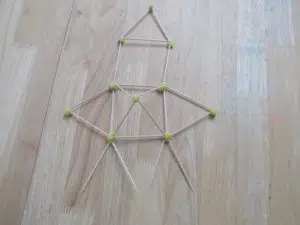
3. Make number aliens
Aliens in general are great for mathematics. Their ludicrous bodies can have ten eyes and fifteen legs and all that kind of thing! It is a true counting goldmine!
Get the children to make the alien body out of dough first, and then simply start adding quantities of body parts.
Make sure they get plenty on!
They need numerous eyes, arms, tentacles etc. This is a great activity to include counting with creation, stimulated by lots of questions about quantity, and one more and less.
This can also be an excellent introduction to symmetry, as children will often build using the same resources one side of their model as on the other (check out the ultimate hands-on symmetry activities here).
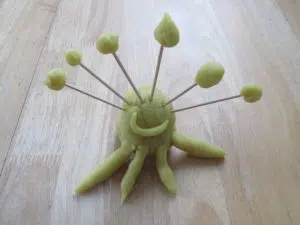
4. Fill the lid!
I use lots of timed challenges with young children. They work well in inspiring engagement, and also for generating a very healthy competitive streak.
Competition in math I believe works very well for counting, because children don’t want to see their friends ‘cheating’ in a game.
If a child has not got reasonable 1:1 correspondence for even a few objects their friends will spot this and not be best pleased. Peer pressure is a good motivator for developing accuracy!
In fill the lid, you have a lid, and an egg timer. Egg timers I would say are better than electric ones, because children can see and understand the concept of time more easily.
Each child takes it in turns. They have thirty seconds to make tiny little balls of playdough and put them in the lid. The more they can put in the lid in the time limit the better!
Once the time is up they can count their balls, and hopefully record them in some way on a ‘champion board’. Simple marks will do the job fine.
Competitions like this are good for understanding which is a bigger number and why. If someone is winning, everyone wants to know why that is.
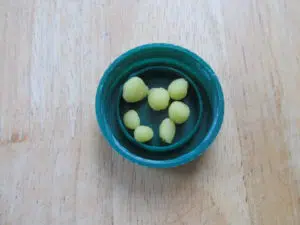
5. Slap the dough subtraction!
I do love a good slap the dough game!
This is one more aimed at the higher ability learners; those that are beginning to explore subtraction practically. It is more easily done verbally, but you could use a written number sentence.
To calculate, for example, six subtract four, what you do is create six balls of playdough. I like to place them in a line.
The first number is the number of balls. The second number (four) is how many balls you slap!
Go for it!
Whack four balls as hard as you can. You could use a wooden mallet or something similar, but a hand or fist is lots of fun by itself.
When you’ve whacked and counted, you can check how many balls are not flattened. This is your answer.
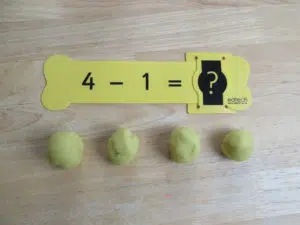
6. Slap the dough patterns
A very similar idea to the last subtraction game.
What you do is make lots of equal balls of dough and put them in a line. Then you start whacking to create a pattern. An easy example of this is to whack the first ball, leave the second, whack the third, leave the fourth…You get a brilliant kinaesthetic pattern emerge, great for active learners.
This slap the dough game can be extended in other ways as well, such as in finding one or two less. This is one of my favorite 21 games that teach patterns that you can read here.
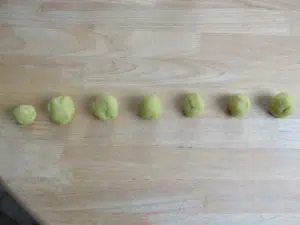
7. Dough aerobics counting
This is best done to some pumping beats.
Any music with a steady, loud beat will work fine. I like to use Daft Punk or Billy Jean, but something current that the children know will certainly work effectively as well, and possibly be even better.
Give out pieces of dough to a group of children and put the music on. Then start slapping, squeezing and rolling to the music.
As you do it count!
Do ten slaps. Do fifteen squeezes. Start counting from different numbers as you squidge that dough.
You can count forwards/backwards, in 2s or 10s with higher ability children. It’s just good to be active, count and develop fine motor at the same time.
8. Making numbers
A simple idea here. Quite simply you roll and stretch the dough into the formation of numerals. It’s useful for them to have a model to copy.
I think it’s good for children to experiment artistically with what numbers look like.
Getting them to create their own number lines, or big class numbers is a excellent project and stimulates them to recognise numbers and see them in the world around them (take a look at the ultimate 16 number recognition games here).
9. Making vehicles
Creating vehicles is a natural and engaging activity, that stimulates talk, creativity and of course number.
This is a good experience to introduce other objects into their malleable play, such as bottle tops, lolly sticks and tin foil.
Vehicles have lots of things that can be counted like seats and wheels, and of course you should always add a few turbo rockets and ejector seats and other similar features. Count, count, count as they build!
10. Playdough maths ten frames.
There are many benefits of children exploring ten frames.
Our number system is based around the number ten. This idea has evolved from the simple fact that we have ten fingers!
If we had twelve fingers, the whole number system would be different and twelve frames would be used throughout the land.
Ten frames help children to visualise numbers in the framework of ten. There are different ways of using playdough in this.
A simple way is to fill a ten frame with a number of playdough balls, for example six.
How many squares are empty?
How many are full?
Is the frame more full or empty?
You can use good old-school playdough cutters for this activity. Cut out some stars and some trees for example.
You can explore number bonds – four starts add six trees equals ten.
You could make patterns in the ten-frame – one tree, one empty space, one tree etc…
11. Use on models and images
Similarly, playdough can be used in creating bringing practical models and images to life.
One of the simplest models and images is two hoops or two circles. This is a useful tool in exploring adding and number bonds.
For example, to explore number bonds to five, create five balls of playdough. Then separate them in different ways across the two hoops.
There are many more models and images activities you can take a look at in my article about the best 50 outdoor maths activities.
12. Make towers
This is a fun game of dexterity and concentration. Have some numbers, and create towers of playdough balls that match.
For example, for the number four, make four small balls of playdough and then try to balance them on top of each other. You’re allowed to squish them a bit but not too much.
13. Sharing between toys.
Making food is a very instinctive playdough activity for children.
A really key mathematical part of this, is the sharing of the food when it is created. If you have six cakes shared between two children, how many do you get each?
If you have three toys, but four slices of pizza, what is going to happen?
How can we sort this situation out?
This is the foundation blocks of simple division and fractions, and also develops problem solving and reasoning skills.
14. Make a family of snakes or worms
This is another good old-school classic. You get the children to make a ‘family’ of snakes or worms. Children like making families, and this is quite a natural activity that you see a lot in their play.
When the families are made, compare height, width, and weight. Count them, order them and talk about all the maths concepts that are involved within this simple activity.
15. Make bugs in different arrays
Children require the experience of counting objects when they are organised in a wide range of arrays.
There are different skills involved in counting objects in a straight line, in a random assortment, in a circle, or in two lines. Lots of fun practice in each of these disciplines is required.
When making bugs, tell the children you are going to make a spell. We are going to put lots of things in the cauldron or magic box.
Let’s all make bugs but count them before we put them in. Then let’s make spiders/butterflies/ants etc. Model how you can place the objects you create in a straight line to aid in counting them.
The Conclusion
Early mathematics and playdough really do seem to go hand-in-hand so well together.
I like to add stories and context to math problems, and playdough offers the imaginative space to create things out of nothing.
Rather than weigh objects, for example, it is so much more engaging to weigh objects that you have created yourself. Also these activities are just starting points for a wealth of extensions and adaptations.
Happy counting and happy squidging!
If you’ve found this useful, then why don’t you check out one of these articles:
